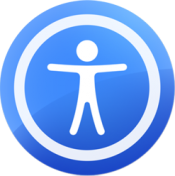Accessibility 101
Published on
January 30, 2014
By Natalie
Digital Project Manager
Accessibility sounds like a good idea, right? The Americans with Disabilities Act (ADA) is legit. Everyone agrees we should have ramps as an alternative to stairs. And who doesn’t love the extra-big bathroom stall? But let’s talk about accessibility online. Does that mean keyboards with braille? Well, no, that’s just silly.
Web accessibility is defined by the folks at Apple as “the successful access to information and information technologies by people with disabilities.” Sounds like another good idea, but let’s have some #realtalk…everything just needs to be equal! Your buddy who is blind needs to check his bank account online just as much as you do. Your family friend who is hard of hearing needs to know the words to the Beyoncé song just as much as you do. And for heaven’s sake, your mother needs to order photo prints online, even if you don’t!

Not only is it the right thing to do (for those obvious reasons), it’s also the smart thing to do: it maximizes your reach, increases search engine optimization (SEO) effectiveness and works well across all browsers/devices. This level of code integrity ensures that accessible websites are ready to handle any new browsers, devices or trends.
If that isn’t enough for you, making your site accessible also happens to be the law! We could get into all sorts of details about this, but basically, if you have a brick-and-mortar presence that complies with ADA standards, your website must comply also. But don’t think you are off the hook, as our day-to-day tasks become increasingly web-based, sites without a corresponding storefront are increasingly responsible for accessibility.
So, how do we make websites equally accessible for all people? Well, the World Wide Web Consortium is a great group that discusses the nitty-gritty of these sorts of web topics. It creates standards for website development so everyone is on the same page. Its full list of accessibility standards can be found here: http://www.w3.org/TR/WCAG20/. Even this list can be a bit overwhelming, so let’s simplify even more. Here are some very basic guidelines to follow:
- Provide appropriate alternate text
- Provide headings for data tables
- Ensure users can complete and submit all forms
- Ensure links make sense out of context
- Caption and/or provide transcripts for media
- Ensure accessibility of non-HTML content
- Allow users to skip repetitive elements on a page
- Do not rely on color alone to convey meaning
- Make sure content is clearly written and easy to read
- Make JavaScript accessible
- Design to standards
At Click Here Labs, we are committed to creating online solutions for the widest possible audience, regardless of circumstance and ability. We make every effort to provide excellent experiences for every user based on the needs and requirements of every client.